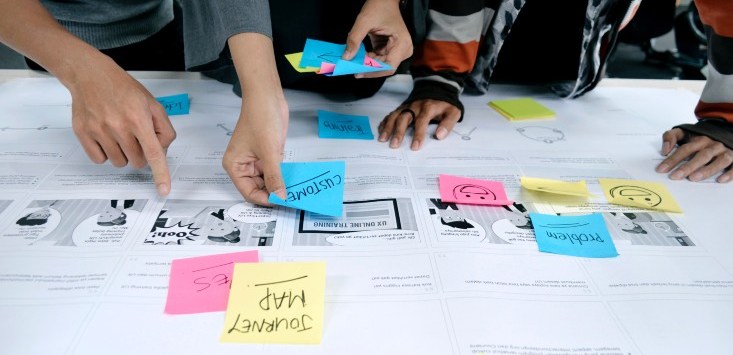
Source: Unsplash/UX Indonesia.
Working across several projects is the norm for most jobs these days. In fact, more than 80% of employees juggle multiple work projects at once, according to recent research.
Such arrangements are pervasive, with 59% of employees working on between two and five projects, 11% on six to 10 projects, and 15% on more than 10 at a time. The rationale behind allocating employees to multiple projects is often billed as increasing productivity, but it’s simply a way to save time, money and resources for firms.
So are these working practices actually beneficial for firms, not to mention employees and the projects they work on? In the aftermath of the COVID-19 pandemic, as we continue to debate excessive work demands, career pressures and job satisfaction (you’ve almost certainly heard about the phenomenon of “quiet quitting”, when employees do the bare minimum to stay on the payroll) this is an important issue to discuss.
And in fact, our new research shows that working on too many projects actually harms performance and is not beneficial for employees, projects or firms. We came to this conclusion after collaborating with a world-leading hydraulic pump manufacturer that has around 20,000 employees in more than 50 countries.
We looked at detailed records of this company’s projects, including monthly key performance indicators (or targets), employee responsibilities and time allocation information. Next, we studied the company’s human resource records and other work registries to gather additional information on its employees. The people we studied varied in rank, experience, gender, role and location. With the use of statistical modelling, we discovered why and how you can reach the optimum workload when assigned to multiple projects.
Five-project limit
After observing hundreds of employees at this large multinational over several years, we found that juggling more than five simultaneous projects can be detrimental to meeting project deadlines. But working on less than five projects can prevent people from achieving maximum productivity.
When working on fewer projects, there is more chance that time will be lost in being idle. For example, if other team members do not deliver their input on time, you can switch over to work on a task for a different project while you wait.
Working on multiple projects can help all kinds of workers to develop more effective work practices. For instance, engineers might deploy automated queuing processes and surgeons can develop flexible priority schemes when working with multiple patients. In other words, employees benefit from creative solutions when working on multiple projects, allowing them to get more done in less time.
So having too few projects is not good. How about too many? We found that employees with more than five projects might experience a lack of focus and stretched brain capacity. For example, such employees might have difficulties being present in the moment. This is called “attention residue” and it has been shown to be pervasive in everything we do. So, next time your boss asks you to jump on another Zoom call to discuss a new project, our research shows you should think twice before accepting.
Ideal conditions
While having five projects might be ideal, not all employees and firms have a choice. The good news is that our research also points to three key conditions for better handling of multiple work projects.
1. Who you are
Research shows that deep specialisation in a task can allow employees to work more efficiently. Think of a logistics specialist who has a combination of relevant education and work experience in supply chains. She can utilise the same practices across all projects without needing to “reinvent the wheel”. Similarly, an engineer who knows everything about a certain type of software can more quickly grasp the requirements of each new project related to that system.
2. Which projects you work on
Similar projects might require almost identical solutions that can be repeated time and again. For example, if a writer works on three or four projects catered toward a similar audience, they can use the same templates or tools to execute certain tasks.
3. Who you work with
Seeing familiar faces across multiple projects saves time on lengthy introductions, misunderstandings and clarifications, according to our research. Colleagues that know each other can rely on shared experiences and use best practices from the past.
In the end, working on too many projects harms employees, projects and firms. It affects employee productivity and morale and can lead to burnout. So, rather than overburdening employees, managers should improve how they allocate their time.
This creates a win-win situation for employees and firms. Companies can still have people work across multiple projects. But to balance productivity and employee demands, they can allocate more specialised workers to simultaneous projects involving familiar faces and similar demands. And that’s how teamwork makes the dream work.![]()
Anatoli Colicev is a chair in marketing, strategy and analytics at the University of Liverpool and Tuuli Hakkarainen is a lecturer (assistant professor) in human resource management at the University of Liverpool.
This article is republished from The Conversation under a Creative Commons license. Read the original article.
Handpicked for you

Research finds 10-minute microbreaks improve employee productivity and alleviate fatigue



COMMENTS
SmartCompany is committed to hosting lively discussions. Help us keep the conversation useful, interesting and welcoming. We aim to publish comments quickly in the interest of promoting robust conversation, but we’re a small team and we deploy filters to protect against legal risk. Occasionally your comment may be held up while it is being reviewed, but we’re working as fast as we can to keep the conversation rolling.
The SmartCompany comment section is members-only content. Please subscribe to leave a comment.
The SmartCompany comment section is members-only content. Please login to leave a comment.